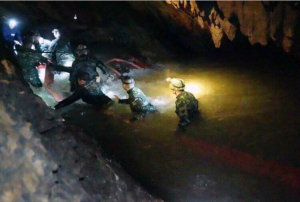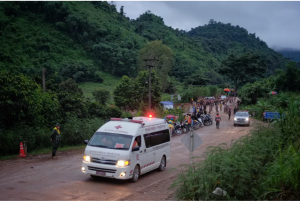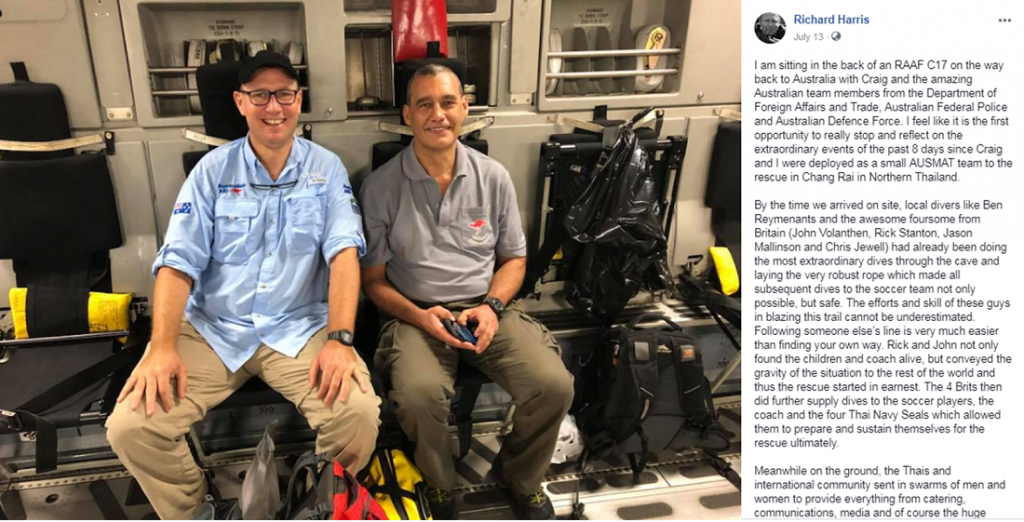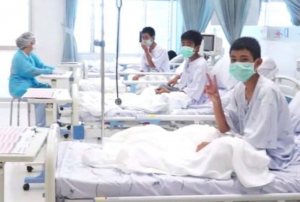17 Jul Update the rulebook: new benchmark in crisis communications set by Thai Cave Rescue
By Robyn Sefiani, Executive Chair and Reputation Counsel
While every crisis is different, the entrapment on 23 June 2018 of 12 young Thai footballers and their coach in a hazardous cave system demanded a unique operational response to rescue the boys in extremely dangerous conditions. As the rescue was delicately executed, the crisis communications response set new benchmarks while breaking some golden rules.
Rule 1: Communicate frequently and transparently
Unlike the Beaconsfield Mine disaster in Tasmania in 2006, where three miners were trapped underground for 14 days, and then-union leader Bill Shorten fronted the media pack with daily or twice daily updates so successfully that it paved his way to Parliament House, communications at Thailand’s Tham Luang cave were less formal and frequent, but every bit as effective and transparent.

Source: The Australian / AP
The unfolding story and its complexities were addressed not in formal daily media conferences, but in brief, sporadic update statements and occasional media conferences by rescue operations chief Governor Narongsak Osottanakorn when there was something new and significant to report: the miraculous discovery of the boys still alive on 2 July, the tragic death of Thai diver Saman Gunan four days later, the disappointing announcement that it was “not suitable” to make the boys dive yet on 7 July, and the much hoped-for announcement on 8 July, “Today is the D-Day. The boys are ready to face any challenges.”
Before the actual rescue began, Thai authorities broadcast an announcement warning media: “During the operation no media on premises are allowed to take photos. Anyone taking unsuitable photos will be held responsible.” This unequivocal statement made it crystal clear to media and to the world: the boys’ wellbeing and privacy was top priority, taking absolute precedence over the world’s hunger for news.
The international media contingent was hastily relocated away from the cave entrance to a spot further afield, to allow 13 ambulances to park close to the entrance and receive the boys if and when they emerged. Journalists did not complain. They understood and wanted the boys safe too. The Australian’s Amber Hodge tweeted: “Kudos to the Thais for the way in which they have accommodated the world media and kept them briefed, not to mention fed and caffeined.”

Source: ABC News / Tham Luang Rescue Operations Centre
It is a truism that in an information vacuum, media will seek updates from unofficial sources; criticism was levelled at some journalists for harassing local Thais for such updates. Twitter prevailed. Amanda Hodge, international Walkley-award winning journalist at The Australian, tweeted 142 updates during the rescue, some of which she sourced from local English Thai TV channel Khaosod English, others from Reuters. Occasionally she would tweet CORRECTION when Reuters updated their facts.

Source: Twitter / Amanda Hodge
Some hours after the rescue was activated, the world heard the news it was waiting for. Lieutenant General Kongcheep Trantrawanit told AFP “Four boys have reached chamber three and will walk out of the cave shortly.” And on the final day of the rescue, the Governor said “If there are no abnormal factors all five will come out today.” Short and sweet. The media cheered.
Rule 2: A single spokesperson
Here, the Thais very effectively broke the golden rule.
While rescue operations leader, Chiang Rai Governor Narongsak Osottanakorn fronted the media conferences, other spokespeople conveyed updates to media on specific topics: Lieutenant General Kongcheep Trantrawanit on behalf of the Thai Navy SEALS who led the rescue effort, Chiang Rai Health Dept Chief Tossathep Boontong for updates on the state of the boys’ health in hospital, and unnamed Thai officials and hospital officials fed small updates to media.
It was the Thai Navy SEALS who broke the news on their Facebook page at 2am on 10 July “Hooyah 12 Wild Pigs and coach out of the cave. Safe everyone. Now waiting to pick up four frogs” (divers). Within 30 minutes it appears there was an update to correct the team name and number of those rescued: “We are not sure if this is a miracle, a science, or what. All the thirteen Wild Boars are now out of the cave.”

Source: Vox.com / Getty Images / Linh Pham
Rule 3: Show empathy and be authentic
Here, the Thais set a new benchmark in empathetic crisis communications. Despite the enormous stress on the crisis management team, official communications were calm, dignified and respectful. Correspondingly, the media covered the story with empathy and emotion. The privacy and welfare of the footballers took precedence, rightly so, over feeding the world’s media with frequent media briefings or dramatic images of those rescued. It was a “need to know” approach rather than sensationalizing the unfolding drama during the rescue. What this conveyed to the world was: our complete focus is on getting all the footballers, their coach and the rescue teams out alive while respecting the families of those whose sons have been rescued and those who still wait and hope. The world understood and shared that hope.
Rule 4: Focus on what matters to resolve the crisis – one decision maker
Many options were considered by the rescue operations leaders. Drill 1km down through the limestone to the entrapped boys? Use birding experts to look for other entrances to the cave? Send cave divers in? And then Elon Musk weighed in with tweets of fantastical solutions. The international response offering help was swift and media conjecture on which solution would be selected ran wild. The monsoonal rains were coming and the rescue “go” date fluctuated from four months to four days. We probably won’t know the true decision-making process until the Hollywood movie comes out replaying the conversations and life-and-death decision-making process, but we can assume the rescue chief took advice from his expert operations team who assessed all the options and timing and made the critical call to send in the Thai Navy SEALS and support team.
Two of those included Australia’s own Dr Richard Harris, who became the ‘face’ of the rescue. To set the record straight Dr Harris wrote on his Facebook page on the plane back to Australia, “The part we (he and Australian dive partner Craig Challen) played has been made out to be a lot more noble that it actually was, we just consider ourselves lucky to have had some skills that we could contribute to the wonderful outcome.”

Source: Facebook / Richard Harris
Elon Musk’s intervention was seen by many as a PR stunt and he is now handling his own reputation issues. Of his proposed mini-submarine solution, the rescue chief said, “Although his technology is good and sophisticated it’s not practical for this mission”. Musk tweeted back saying the Governor was “not the subject matter expert”. In a CNN interview several days after the rescue, one of the British rescue divers said “It had absolutely no chance of working. He (Musk) had no conception of what the cave passage was like.”

Source: Twitter / Elon Musk
Rule 5: Respect cultural sensitivities
The Thai culture is founded in Buddhism and its people are frequently portrayed as calm and respectful. Buddhist monks sat vigil outside the cave entrance praying for the boys’ safe return, as did the parents of the entrapped boys. It has now become clear that the 25-year-old coach’s meditation training as a Buddhist monk played a role keeping the boys alive and relatively healthy until rescuers arrived. Local rice farmers whose crops and livelihood were destroyed by the tonnes of water pumped from the caves said it didn’t matter – the boys were now safe. Governor Narongsak said on 11 July: “The children are neither heroes nor villains. They’re simply kids having an accident. Now that they’re known to millions of people, I believe they would contribute to the betterment of society in future.”
By every measure the crisis management effectiveness of the Thai cave rescue was best-practice and a stunning success, except for the sad loss of life of Saman Gunan. While crisis communications didn’t follow “the book”, it was effective and focused on what mattered when it mattered, putting the rescue of the footballers, their coach and the safety of the rescue team above the media’s thirst for constant updates and sensational images. The media and the world just had to wait a little, and it was well worth the wait, with an outcome better than anyone could have anticipated.

Source: ABC News / AP: Thailand Government Spokesman Bureau

Source: NY Post / Getty Images

